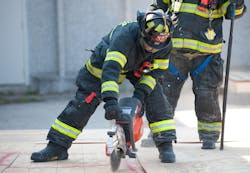Pennington: Goodbye Vertical Ventilation?
Command to Truck 1, when you arrive on the scene do not get on the roof!"
"Truck 1 to command, is it unsafe?"
When was the last time that you ever stopped and thought about putting a firefighter on the roof of a burning building? Was your first thought about how well the crew could perform vertical ventilation or when was the last time that they had trained under real conditions? These questions should be answered by any officer in today's fire environment as we are dealing with new challenges everyday.
Lightweight construction, overloaded homes, fuels of solidified petroleum products and many other factors should be considered if you are going to open the roof. The most important factor should be the skill level of your firefighters.
I know a bunch of my readers wear many hats in the fire department: emergency medical provider, fire inspector, and other duties that take us away from the consistent training that keeps us #jumpseatready. Dividing your time between these requirements limits the time available to practice firefighting. It's pretty common in my conversation with others that vertical ventilation can be placed at the lower end of the importance level as many departments do not have a truck or enough firefighters on scene to safely make the cut and open up.
Think about it. When was the last time you had the chance to practice your vertical ventilation techniques? Was your last chance under "real" conditions? One area that this jumpseat rider believes we fail in training firefighters is that we don't make it realistic. When we drill on vertical ventilation we don't use tar paper, shingles, or aluminum and these are all of the materials we will face when performing at a real fire. We use plywood or OSB and often couple this with only allowing student to make small holes instead of the four-by-four eight-by-eight-foot holes that are required to vent real fires.
Does training like this set us up for failure?
Now, back to how often you train for roof ops? If you are assigned to an aggressive, busy, and well-trained truck company you make get this chance once a week. But let's be honest, most of us are not given this opportunity and feel lucky that we are able to refresh these skills once a quarter. Does this really prepare us for a safe operation?
Let's add in one more variable to this equation. What type of saws does your department have available for you to use? Rotary or chain saws both require attention to maintenance after every use.
Many saws are sitting in their compartments right now that take more times pulling the cord then there are hours in the day. Small engine maintenance and repair takes a dedicated crew with religious attention to the details to ensure that they can start with two pulls and are ready for work. Additionally many saws purchased today are not intended for fire department use and prove useless when cutting through shingles, tar paper, or a nail. Having a knowledgable person in the purchasing process will insure this will not happen in your department.
So, are you ready to get on the roof?
Is vertical ventilation really an option for your department?
Going vertical with ventilation can be an effective means of stopping horizontal fire spread while making interior conditions better for an advancing hose team, but it take a well-trained group of firefighters who have trained in realistic conditions to perform. WIthout realistic training, equipment that is prepared and suited for the job a crew placed on the roof will be there set up for failure. Is this a place where you would like to fail?
The next time you hit the training grounds add the shingles and tar paper, and practice making a full-size hole while wearing all your PPE, including SCBA, to make sure you are ready to go vertical on your next fire!
